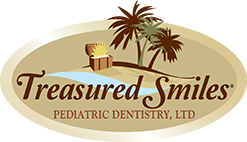Pediatric Treatment
Our practice provides a wide range of dental services for your children. Our emphasis is on total preventive care for our patients and our comprehensive treatment plans are performed with the highest level of expertise and care.
Dental Cleanings
You should schedule routine dental cleanings for your child every 6 months. During this visit, one of our dental hygienists will remove plaque and debris from your child's teeth, especially from places where the brush can't reach, such as underneath the gumline and in-between teeth. After cleaning your child's teeth, fluoride will be applied to help protect their teeth from cavities once they leave the office.
Fluoride is an important advancement in dental and oral health. Studies consistently show that a moderate but consistent exposure of teeth to fluoride helps strengthen and rebuild tooth structure, and helps prevent future decay.
If your child is due for a teeth cleaning, please call our dental office in Frankfort, Illinois to schedule an appointment. We service New Lenox, Mokena, Homer Glen, Lockport, Tinley Park, and neighboring areas!
Fillings
The concept of a "filling" is replacing and restoring the tooth structure that is damaged due to decay or fracture with a strong, natural looking, white composite material. We may also replace old, broken-down amalgam/metal fillings that contain traces of mercury with composite (white) fillings to restore your child's tooth to better health.
Extractions
An extraction is the complete removal of a tooth. Extractions are sometimes necessary if a primary tooth is preventing the normal eruption of a permanent tooth, if the tooth has suffered extensive tooth decay or trauma that cannot be repaired, if the patient has gum disease, or if the tooth is impacted (usually the wisdom teeth). Depending on the complexity of the case, an extraction can be performed surgically or non-surgically. A mild anesthesia is used to ensure your child is as comfortable as possible throughout the procedure.
Digital Imaging
We are proud to utilize the latest technology available to ensure our patients enjoy the best results. We use high-resolution digital photography to capture detailed images of your child's mouth, thus enabling us to maintain sharp, accurate records and keep you thoroughly informed of your child's treatment progress.
We also offer one of the latest technological advances in dentistry with digital radiography, also known as digital X-rays. A wireless sensor is placed in the mouth, and a computer generates an image in 30 seconds as opposed to the general 4-6 minute wait time for images taken on dental film. These X-rays can also be enhanced on the computer and enlarged.
Not only are they friendly to the environment, they are much safer than traditional X-rays. Digital radiographs reduce a patient's radiation exposure by 90 percent!
Laser Cavity Detection - Cavities in Baby Teeth
Did you know that half of the cavities found in your child's teeth could go undetected without the help of latest technologies? However, our office offers a diagnostic method that can more accurately define teeth cavities, even cavities in baby teeth.
We offer a unique service that can detect an oral cavity at the earliest stage. The Laser Caries Detector is over 90 percent accurate in detecting even the smallest lesions that don't even appear on X-rays! Early detection enables us to better preserve and protect your teeth.
The Laser Caries Detector boasts a high patient acceptance and satisfaction with its quick, simple and painless nature when detecting a tooth cavity.
Sealants
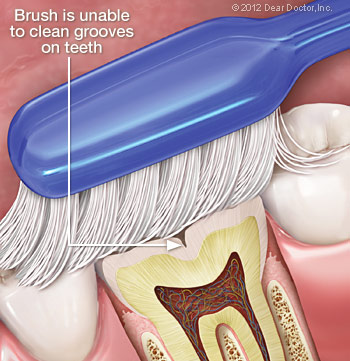 The most likely location for a cavity to develop in your child's mouth is on the chewing surfaces of the back teeth. Run your tongue over this area in your mouth, and you will feel the reason why: These surfaces are not smooth, as other areas of your teeth are. Instead, they are filled with tiny grooves referred to as "pits and fissures," which trap bacteria and food particles. The bristles on a toothbrush can't always reach all the way into these dark, moist little crevices. This creates the perfect conditions for tooth decay.
The most likely location for a cavity to develop in your child's mouth is on the chewing surfaces of the back teeth. Run your tongue over this area in your mouth, and you will feel the reason why: These surfaces are not smooth, as other areas of your teeth are. Instead, they are filled with tiny grooves referred to as "pits and fissures," which trap bacteria and food particles. The bristles on a toothbrush can't always reach all the way into these dark, moist little crevices. This creates the perfect conditions for tooth decay.
What's more, a child's newly erupted permanent teeth are not as resistant to decay as adult teeth are. The hard enamel coating that protects the teeth changes as it ages to become stronger. Fluoride, which is found in toothpaste and some drinking water — and in treatments we use here at the dental office — can strengthen enamel, but, again, it's hard to get fluoride into those pits and fissures on a regular basis. Fortunately, there is a good solution to this problem: dental sealants.
Dental sealants are invisible plastic resin coatings that smooth out the chewing surfaces of the back teeth, making them resistant to decay. A sealed tooth is far less likely to develop a cavity, require more expensive dental treatment later on, or, most importantly, cause your child pain.
How Sealants Are Placed
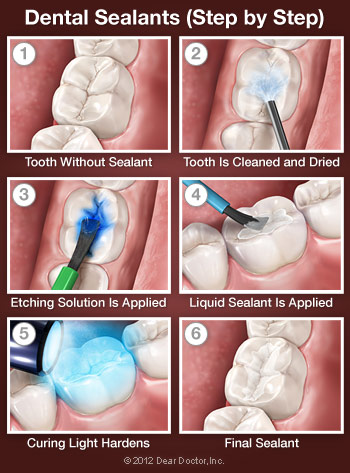
You can think of a sealant as a mini plastic filling, though please reassure your child that it doesn't "count" as having a cavity filled. Because tooth enamel does not contain any nerves, placing a sealant is painless and does not routinely require numbing shots. First we will examine the tooth or teeth to be sealed, and if any minimal decay is found, it will be gently removed. The tooth will then be cleaned and dried. Then we will apply a solution that will slightly roughen or "etch" the surface, to make the sealing material adhere better. The tooth is then rinsed and dried again. The sealant is then painted on the tooth in liquid form and hardens in about a minute, sometimes with the help of a special curing light. That's all there is to it!
A note about BPA: A 2012 study that received wide press coverage raised concerns that trace amounts of the chemical bisphenol-A (BPA) found in some (but not all) dental resins might contribute to behavioral problems in children. The study authors noted that while they had found an association, they had not actually proven that BPA in dental sealants causes these problems. In fact, BPA is far more prevalent in food and beverage packaging than in dental restorative materials. The American Academy of Pediatric Dentistry and the American Dental Association have since reaffirmed their support for the use of sealants. We would be happy to answer any questions you may have regarding this issue.
Taking Care of Sealants
Sealed teeth require the same conscientious dental hygiene as unsealed teeth. Your child should continue to brush and floss his or her teeth daily and visit us for regular professional cleanings. This will give us a chance to check for wear and tear on the sealants, which should last for up to 10 years. During this time, your child will benefit from a preventive treatment proven to reduce decay by more than 70 percent.
Related Articles
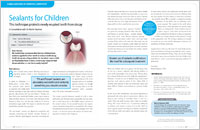
Sealants for Children The tiny grooves in your child's back teeth are ideal places for cavities to form. But you can take a proactive role in preventing this with dental sealants. These are protective plastic resin coatings placed in these tiny pits and fissures of teeth, actually sealing them from attack. It's a wonderful method of decay prevention that every parent should consider... Read Article
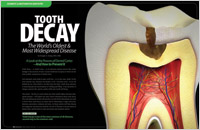
Tooth Decay — A Preventable Disease Tooth Decay is perhaps the number one reason children and adults lose teeth during their lifetime. Yet many people don't realize that it is a preventable infection. This article explores the causes of tooth decay, its prevention, and the relationship to bacteria, sugars, and acids... Read Article
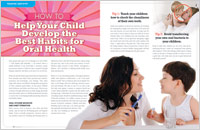
How to Help Your Child Develop the Best Habits for Oral Health Proper oral health habits are easy to learn — and lead to behaviors that result in lifelong dental health. And the time to begin is as soon as your child's first baby teeth appear. From toothbrushing for your toddler to helping your teenager stay away from tobacco, Dear Doctor magazine offers the most important tips for healthy habit formation through childhood and beyond... Read Article
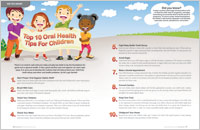
Top 10 Oral Health Tips for Children There's no need to wait until your baby actually has teeth to lay the foundations for good oral or general health. In fact, good nutrition and oral hygiene can start right away. It is up to you to develop the routines that will help protect your child from tooth decay and other oral health problems. So let's get started... Read Article
